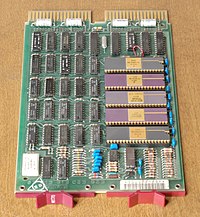
Photo from wikipedia
Objectives Pupil light reflex (PLR) has been widely used as a method for evaluating parasympathetic activity. The first aim of the present study is to develop a PLR measurement using… Click to show full abstract
Objectives Pupil light reflex (PLR) has been widely used as a method for evaluating parasympathetic activity. The first aim of the present study is to develop a PLR measurement using a computer screen set-up and compare its results with the PLR generated by a more conventional setup using light-emitting diode (LED). The parasympathetic nervous system, which is known to control the ‘rest and digest’ response of the human body, is considered to be associated with daily life fatigue. However, only few studies have attempted to test the relationship between self-reported daily fatigue and physiological measurement of the parasympathetic nervous system. Therefore, the second aim of this study was to investigate the relationship between daily-life fatigue, assessed using the Need for Recovery scale, and parasympathetic activity, as indicated by the PLR parameters. Design A pilot study was conducted first to develop a PLR measurement set-up using a computer screen. PLRs evoked by light stimuli with different characteristics were recorded to confirm the influence of light intensity, flash duration, and color on the PLRs evoked by the system. In the subsequent experimental study, we recorded the PLR of 25 adult participants to light flashes generated by the screen set-up as well as by a conventional LED set-up. PLR parameters relating to parasympathetic and sympathetic activity were calculated from the pupil responses. We tested the split-half reliability across two consecutive blocks of trials, and the relationships between the parameters of PLRs evoked by the two set-ups. Participants rated their need for recovery prior to the PLR recordings. Results PLR parameters acquired in the screen and LED set-ups showed good reliability for amplitude related parameters. The PLRs evoked by both set-ups were consistent, but showed systematic differences in absolute values of all parameters. Additionally, higher need for recovery was associated with faster and larger constriction of the PLR. Conclusions This study assessed the PLR generated by a computer screen and the PLR generated by a LED. The good reliability within set-ups and the consistency between the PLRs evoked by the set-ups indicate that both systems provides a valid way to evoke the PLR. A higher need for recovery was associated with faster and larger constricting PLRs, suggesting increased levels of parasympathetic nervous system activity in people experiencing higher levels of need for recovery on a daily basis.
Journal Title: PLoS ONE
Year Published: 2018
Link to full text (if available)
Share on Social Media: Sign Up to like & get
recommendations!